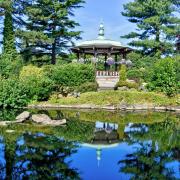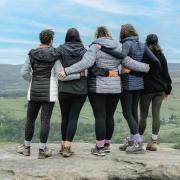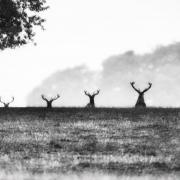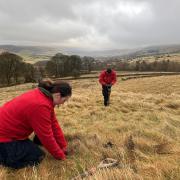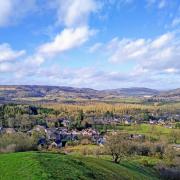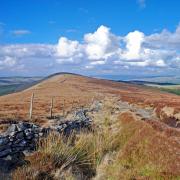The Peak landscape has played an inspiring and influential part in the life and career of artist Kristan Baggaley. Mike Smith visits him at his Nether Edge studio
Artist Kristan Baggaley has a very singular way of painting. His canvas is attached to the wall of his studio and he works on it from a standing position at the head of an aisle flanked by two long tables, one of which is covered by pots of paint and the other by bags of grit and twigs of gorse and heather. From time to time, he retreats down the aisle, which runs towards the open door of his adjacent gallery, so that he can move into the next room and appraise his work from a distance. When he returns to the canvas and resumes painting, he has to work at arm’s length because there is a conical mound of congealed grit between his feet and the wall of the studio.
As I would discover during the course of our conversation, that mound of grit provides an important clue to the way Kristan manages to produce paintings of the Dark Peak which simultaneously capture the texture of the rocks, the play of light on the flora, the mood of the weather and the romance of the moors. Lots of unfinished paintings hang on the walls of his large studio, because he often returns to a canvas to add further touches until he is satisfied that the work is complete. His finished paintings are displayed next door, on the white walls of his equally large gallery space.
The gallery and studio form two halves of a converted garage in Nether Edge, a south-western suburb of Sheffield. His home, which he shares with his partner Lucy, a jeweller and organiser of school art projects, is conveniently situated across the road. Our conversation was conducted in a corner of the gallery, where I felt that I was being magically transported from the city to the moors, not only because we were surrounded by Kristan’s atmospheric paintings of the landscape, but also because the temperature in the studio was almost as low as it is on a winter’s day in the Dark Peak!
Kristan told me that he had spent his childhood in the suburb of Totley, where Sheffield meets the moors which are now the main inspiration for his work. He was educated at the local comprehensive school and took A-levels in Art, Biology and Geography. Recalling his reasons for choosing these subjects, he said: ‘I hoped that they would enable me to find out more about the natural environment and allow me to interpret it, but I was disappointed by the way Geography and Biology were taught and I spent most of my time in the art room, the only place where I was really happy.’
Although his parents encouraged him to take up landscape architecture as a career, Kristan was determined to go his own way. He took an art foundation course at Sheffield Polytechnic and then went to Nottingham Art College to study for a degree in Fine Art. Once again, he was not particularly inspired by the teaching he received, other than by the input from some visiting lecturers, particularly Stuart Brisley, an artist who has always challenged cultural expectations.
Kristan was equally independent as an artist, insisting on producing vast abstracts. He said, ‘I would stand on a step-ladder and work on the canvas in a very physical way.’ When these large works were exhibited in his degree show, they gained him the top painting prize and the Stowells Trophy, which meant that he was selected to exhibit at the Royal College of Art. A lecturer from Chelsea was so impressed by Kristan’s work that he tried to persuade him to take an MA course at his college.
Recalling the accolades that emanated from his degree show, Kristan said: ‘This was the great “what if” moment of my life. I’d made a big impression but, for some reason, I didn’t accept the place at Chelsea. Perhaps I was disillusioned with the teaching I’d experienced. Perhaps I simply wanted to earn money rather than study. For whatever reason, I trained to be a teacher and obtained a job at a school in Birmingham. That didn’t work out either, because I couldn’t stand the sound of the lesson bells – they brought back all the negative feelings about my own schooldays.’
Kristan gave up his job, went back to Nottingham, signed on the dole, lived in a council flat and attended a good number of wild parties, but managed to devote plenty of time to painting, without having the slightest notion of how he could market his work. After a year of selling very few pictures, he obtained a low-paid job as an art instructor at a centre for disaffected young people, where his enthusiasm for teaching was rekindled. He said, ‘I really loved the work because I felt that I was helping to turn around lives.’
Two teaching jobs in schools followed. The first was at a school in the Gower Peninsula, where he fell foul of the headteacher for not wearing a tie. The second was at a school in Bimingham, where he regarded the art room as his ‘own little kingdom’ and was perfectly happy to receive and help the naughty children who were sent there by teachers who had ejected them from their classes.
After being promoted to the post of Head of the Creative Arts Faculty, Kristan shocked his colleagues by resigning because he couldn’t stand the management responsibilities that went with the job, not least because they gave him no time to pursue his art. Having given up a teaching job for the second time in his life, he decided to travel around Europe with Lucy, making frequent stops, particularly in the ports of northern Italy, to paint local scenes and sell his pictures. On their return to England, the couple accepted an offer from Lucy’s mother for them to take over her bed and breakfast business in a big rambling house in Staffordshire, where Kristan had plenty of space to set up a studio.
When Lucy decided that she wanted to enrol on an art foundation course in Sheffield, the couple left the B&B and moved to the Firth Park area of the city. Kristan realised that this was the moment for him to try being a full-time artist. His paintings at the time were quite small and concerned with the arrangement of shapes and colour, but his subject matter changed dramatically when the couple moved to Nether Edge, from where Kristan could cycle to the Dark Peak and sketch en plein air.
He told me: ‘I became entranced by the contrast of darkness and vibrancy on the moors and by the influence of the seasons, the weather, the light and the atmosphere on the colour of the land. Finding that a particular place looked very different every time I visited it, I got into the habit of painting the same scene time and time again, always trying to illustrate the mood of the moment.’
Kristan has succeeded in depicting those changing moods to perfection because he has developed a very particular way of painting. Recapturing the very physical approach of his art college days, he attacks his canvas, not only with splatterings and scrapings of paint, but also with small pieces of gorse, heather and gritstone, all of which are indigenous to the Dark Peak. He builds up layer upon layer of these mixed components until his painting becomes a landscape in itself.
As well as portraying the moors, Kristan makes painting trips to the coast of North Cornwall, where he has discovered similar mood changes and lack of permanence in the landscapes and seascapes. After struggling for a long time to ‘capture the turquoise of the sea’, he now revels in the chance to paint there, whilst retaining the Dark Peak as his main subject. Thanks to his talent and the effectiveness of his ‘gritty’ technique, Kristan’s ‘sculptured canvases’ are in great demand and he has made a good living as a full-time artist for the last 15 years. This is one job that he will not be giving up.
Kristan Baggaley’s studio is at 10 Oakhill Road, Nether Edge, Sheffield, S7 1SH. Visits can be arranged by phoning 0114 2550945 or by emailing kristanbaggaley @hotmail.co.uk. Kristan will be holding open studios on 4th, 5th, 6th, 11th and 12th May, 11am-5pm, and his work can be viewed at the Derwent Gallery in Grindleford and at gallerytop in Rowsley.



